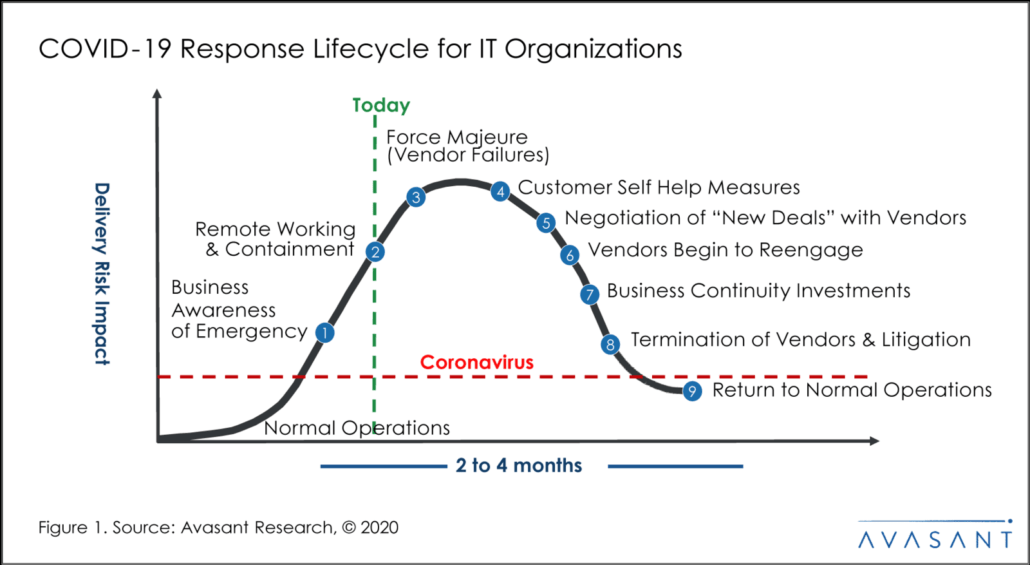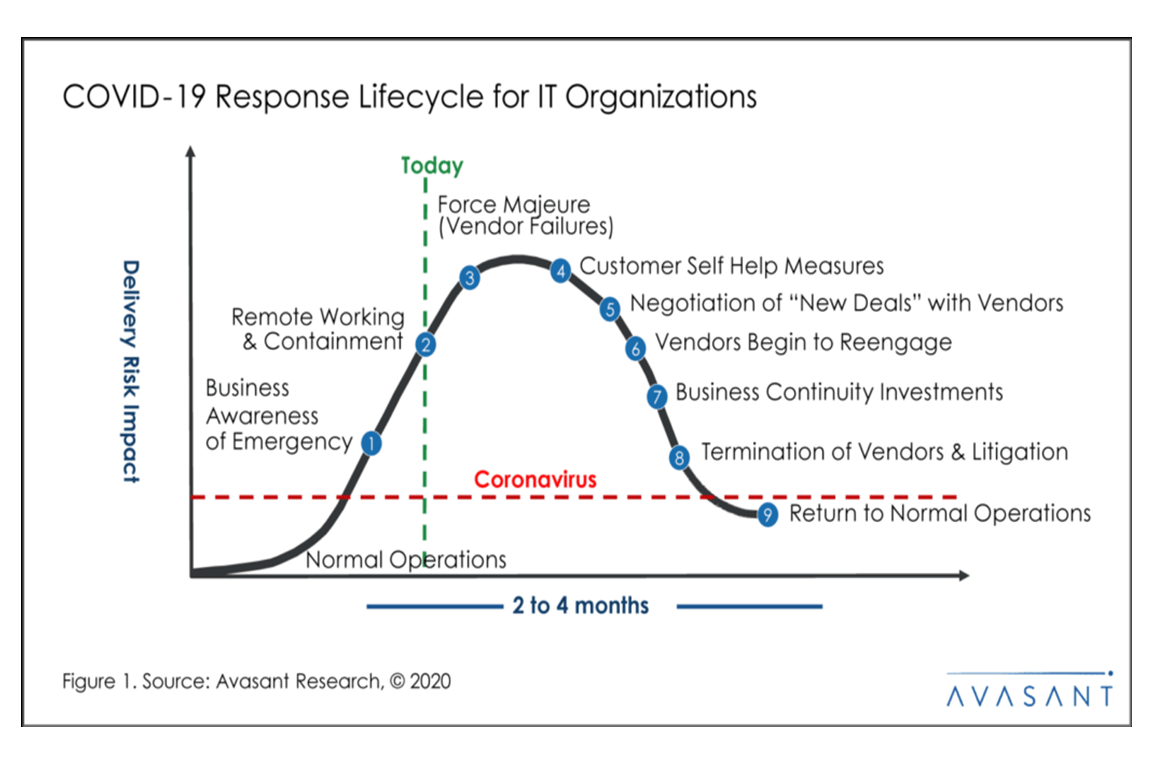What IT Organizations Can Expect for a COVID-19 Recovery
As the COVID-19 global pandemic continues, IT leaders are asking how long this will continue, what actions they should take, and what they can expect in terms of a recovery. In other words, what is the life cycle of a pandemic for IT organizations? And how should organizations plan to tackle the challenges coming their way?
It is important to understand that this life cycle will involve the reorganization of IT delivery, possible force majeure events with vendors, and a requirement to renegotiate support agreements with third parties. This Research Byte lays out the expected life-cycle stages for the current pandemic and its impact on IT services short-term and long-term. It is based on a full presentation, COVID-19 Impact on IT Organizations and Service Provider Relationships, by Avasant CEO, Kevin Parikh, which has been newly updated as of April 2020.
The Lifecycle of a Pandemic for IT Organizations
To understand what IT organizations can expect in terms of recovery, it is helpful to think of the life-cycle stages of a pandemic scenario, as shown in Figure 1. In the figure, the risk to delivery of IT services is shown on the vertical access, and time is shown on the horizontal access.
As it became apparent in early 2020 that a pandemic was underway, business leaders became aware of the situation (Stage 1). Their natural first response was to implement remote work arrangements—at least for those employees and contractors who could work from home (Stage 2). For those who cannot work from home, organizations are implementing strict containment measures, such as mandatory separation between workers and more frequent and deeper workplace cleaning. At the time of this writing, in late March 2020, most organizations in the US and Europe are at this stage.

But what can IT leaders expect going forward? The next step will be failure by many IT services providers in meeting their service level agreements (Stage 3). This could be simply a matter of not meeting contracted service levels, or it could mean outright failure to deliver services, leading providers to invoke force majeure clauses of their contracts. At this point, the risk to the IT service delivery is at its greatest level.
With service providers failing to deliver, customers will have few options other than to call upon other service providers or even take on the work internally (Stage 4). Most well-conceived managed services agreements will contain self-help provisions that permit the customer to hire emergency services when a provider is unable to deliver. Generally, these provisions allow the offset of fees against the provider that is not performing. For example, if a help desk service provider is unable to deliver, a client may set up its own in-house support desk or seek help from another provider to provide at least a minimal level of support to users. Unfortunately, with a large population of employees working from home, this will take place at a time when user support needs will be at their highest.
The increased need will lead customers to negotiate new deals with service providers, whether they be with the incumbent vendors or other vendors better able to deliver (Stage 5). As vendors themselves recover from the pandemic, they will then be in a position to reengage with customers (Stage 6).
At this point, the risk to IT service delivery is declining, and customers will be in a position to revisit their business continuity plans and apply lessons learned (Stage 7). This will lead to increased investments in disaster recovery and business continuity capabilities. These could include engaging with multiple vendors for IT services, so that the risk is spread over multiple providers. Unfortunately, some service providers will need to be terminated, and in some cases, lawsuits will ensue (Stage 8).
Our expectation is that these stages could take place over a timeframe of as little as two to four months, although a full return to normal operations (Stage 9) will likely result in a higher level of risk than organizations experienced prior to the pandemic.
Impact of the Pandemic on IT Services Short-Term and Long-Term
Major disasters often accelerate changes that are already taking place in the IT industry. For example, security was already a growing concern in the late 1990s, but it became an even greater focus after the terrorist attacks of September 11, 2001. So also, there are a number of trends that will likely be accelerated as a result of the current pandemic. These include the following:
- Remote delivery and work models: Customers as well as providers are making increased investments in Unified Communications and remote working technologies. Once workers have been deployed to work from home, some of them will continue even after quarantines are lifted. Our recent research report indicates that the trend to telecommuting was well underway, even before the current pandemic.
- Redefining relationships: Likewise, once customers get used to service providers and vendors delivering more of their services remotely, they will not require as much to be delivered onsite, saving in travel expenses and potentially improving productivity.
- Increased offsite/offshore: If service providers are not allowed to work onsite at customer locations, there is less of an incentive to maintain as many personnel close to customer locations, and a greater percentage of the work will move offshore.
- Restructuring contracts: Contracts need to be both outcomes based and focused on integrated business capabilities across the front and back office. This is a move away from traditional IT service towers.
- Automation as an enabler: As providers have difficulty in maintaining workforce productivity, the trend toward robotic process automation (RPA) and service automation will accelerate, driving greater efficiencies, faster response, and improved service performance.
- New compensation structures: As customers become more sensitive to providers’ performance, they will seek gain-sharing and risk-sharing arrangements, to link vendor performance and compensation to tangible business impacts.
Some of these impacts, such as increased use of remote access and offshore delivery models are already being felt. Others, such as increased use of gain-sharing and risk-sharing compensation structures will be felt more gradually, as contracts come up for renewal.
Perhaps the greatest impact, however, will be with the majority of IT organizations finally including pandemics in their scenarios for business continuity planning. As noted in prior research, pandemics present special challenges for business continuity planners. Unlike other natural disasters, pandemics are worldwide in their scope, much longer in duration, and impact workers instead of systems and facilities, among other factors. These characteristics call for specific contingency measures that are unlike many actions taken in the event of an earthquake, hurricane, or power outage.
The current pandemic crisis is unprecedented in its impact on IT organizations and service providers worldwide. Nevertheless, we can begin to see a path ahead, in stages, to recover to a new-normal of business conditions. The lessons learned now, and updated business continuity plans, will change IT organizations and their relationships with service providers for many years to come.
This Research Byte is based on a presentation by Avasant CEO Kevin Parikh, COVID-19 Impact on IT Organizations and Service Provider Relationships. Newly updated for April, 2020, the full presentation lays out the expected life-cycle stages for the current pandemic and its impact on IT services short-term and long-term. It also outlines specific contractual and legal considerations that IT leaders should understand in renegotiating relationships with service providers.






